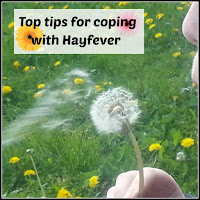Hay fever is a common, and really annoying, seasonal problem for many people. It isn't always taken seriously, but the symptoms can be similar to those of a heavy cold. Although not life-changing, these symptoms can leave the sufferer feeling exhausted and miserable, especially as they can last for most of the summer. The condition is a particular nuisance for students, as it tends to land right in the middle of exam season, which is the last thing anyone needs. I've put together a few tips that I hope might help, including some ideas we've tried and some that we might! Wishing you a healthy, snuffle-free summer!
Prevention
There are some steps you can take relatively easily that will help keep hayfever symptoms at bay as much as possible.
- Pollen is concentrated inland, as the sea breeze drives it inward, so if you can spend as much time as possible at the coast, the air will be clearer and it will give much needed relief. Although the pollen count is often lower in cities, pollution can make symptoms worse. If you live or work in the city, plan your day so you are not outside during early morning or late afternoon, when pollen counts are at their highest.
- Particularly if you have long hair, wash it daily in the summer, if possible. Also change your clothes as often as you can, particularly if you have been outside. Pollen sticks to fibres and fabrics, so you don't want to be carting it around with you. Equally, be aware of pollen on pet's fur, brush them well and try not to let them near your face, especially when they've just been outside.
- An obvious one, but bring the washing in as soon as it's dry, and don't, if you can avoid it, leave it out if anyone is cutting grass nearby. If you have to cut your own grass, shower and change your clothes as soon as you can afterwards.
Drug-free Remedies
Especially where children are concerned, parents are often keen to avoid unnecessary medicines, if they can. There are various drug free options available for the treatment of hay fever such as;
- Electronic Allergy Reliever. This device gently clips on to the nasal septum and is worn for a few minutes at a time. It uses red light therapy to suppress the histamine-releasing cells. When Jade was much younger she used one of these all the time and it seemed pretty effective. It's always hard to quantify, as it's impossible to say how much worse it would have been without it, but I would say it's definitely worth a try if you are struggling.
- Haymax Allergen Barrier Balm. This product is applied to the rim of the nostrils. It can provide relief from many allergy symptoms, such as; pet dander, or dust, but is particularly useful in the treatment of hayfever as it is drug-free and won't cause drowsiness. It won't effect your ability to drive and can be safely used by children and breastfeeding mothers,due to its natural, organic ingredients. I haven't personally used this product, but have heard good things about it, it's even won awards!
- Electric Air Purifier. Jade has had an air purifier in her bedroom for many years and I highly recommend getting one if hay fever is a persistent problem. It has been really helpful to her to have one room where the air is clearer and she can get away from the pollen onslaught. Since we bought her first air purifier, more than ten years ago, the quality and effectiveness has improved dramatically. Recently, we reviewed the Vax Pure Air 300, which is a great example of the advances in air purifying technology, with a filter which pumps the cleaned air back into the room and even a remote control!
There are some natural remedies that sufferers swear by, although there is little scientific evidence to support the benefits reported. However, as they are natural and low cost, it wouldn't hurt to give them a try. Local honey can be bought from a Farmer's Market or Farm Shop and is believed to desensitise your body by exposing it to pollen in small doses. Chamomile has natural antihistimine properties and can be drunk or, and this is the best bit, the tea bags can be left to cool after making a brew and placed on the eyes for a lovely, soothing experience. Vaseline is great for relieving itching by smearing around the eyes (this is not an official use, so proceed with caution, but I've done it for years!) and also around the rim of the nose, to trap the pollen. Whatever you try, I hope you find something that works and, if all else fails, invest in a raincoat and hope for a downpour!





No comments
Post a Comment